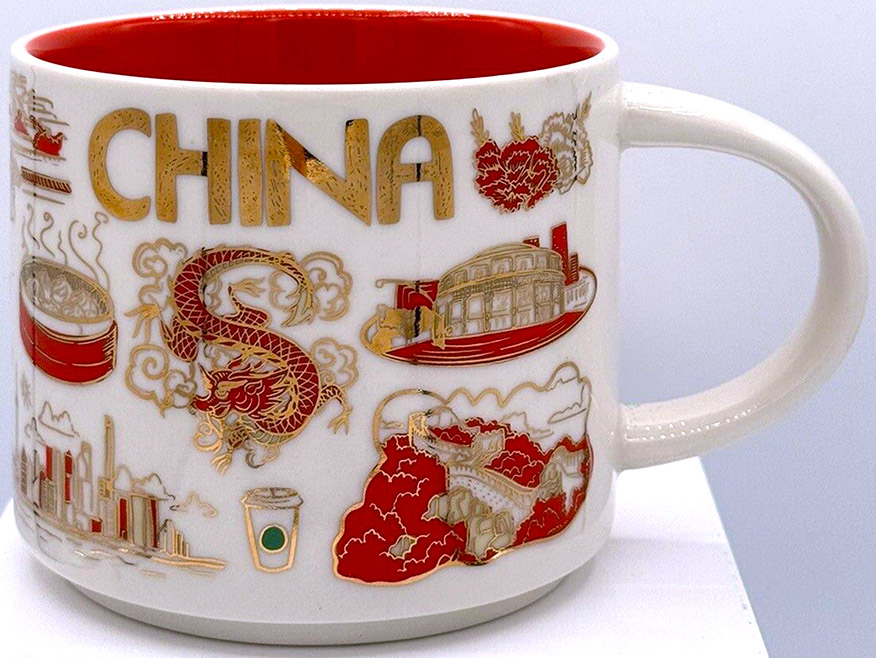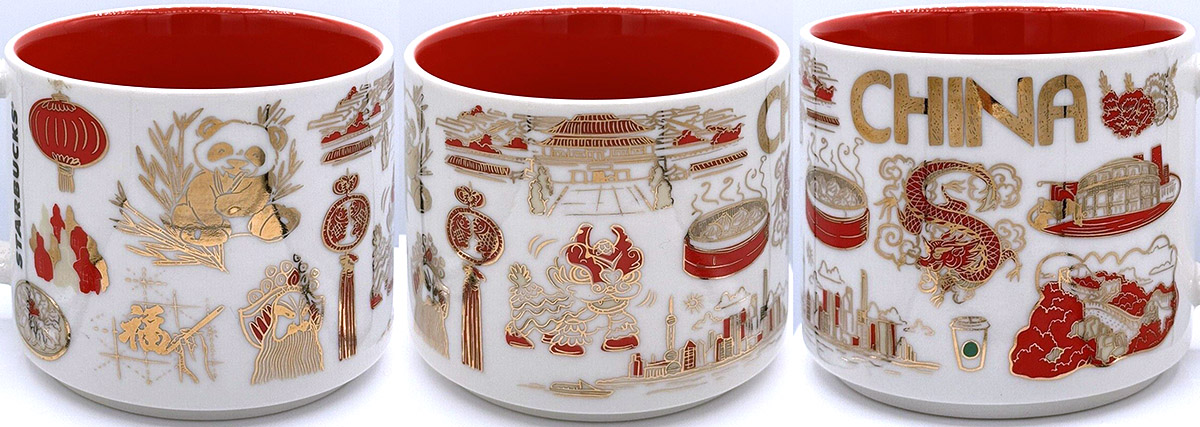
Been There – China
Starbucks Been There – China is probably the best-looking mug from this series that I’ve seen. The designers did a great job while using bright red and shiny gold colors. This, however, comes with the inconvenience of not being able to use it in the microwave or dishwasher. Please note, that there are dozens of Been There city mugs from China that I will be adding soon, stay tuned!
There are many symbols and points of interest from China that can be seen on the mug. Here are some of them:
– The Great Wall of China, an extraordinary feat of ancient engineering, spans approximately 13,000 miles across the northern borders of China. Construction of the wall began as early as the 7th century BC and continued for centuries, with various dynasties contributing to its expansion and fortification. Remarkably, some sections of the wall date back over 2,000 years. The wall’s formidable structure consists of stone and earthen walls, punctuated by watchtowers and fortresses strategically placed along its length. Despite its original purpose of defense against invasions, the Great Wall also served as a symbol of unity and strength for the Chinese civilization. Today, it remains one of the most iconic and visited landmarks in the world, attracting millions of tourists each year to marvel at its grandeur and historical significance.
– In Chinese culture, the Dragon holds profound symbolic significance, representing power, strength, and good fortune. Unlike the Western portrayal of dragons as malevolent creatures, Chinese dragons are revered and often associated with imperial authority and auspicious qualities. Throughout Chinese history, the dragon has been a symbol of the emperor, embodying the ruler’s authority and divine right to govern. It is also closely linked to water-related phenomena like rainfall and rivers, making it a symbol of fertility and abundance. Additionally, dragons are believed to bring protection and prosperity, and they are frequently depicted in various forms of art, architecture, and cultural festivities.
We can see one dragon on the front of the mug and another one on the side. The second though, is a reference to the Dragon Dance, a captivating and vibrant form of traditional dance in Chinese culture. It is most commonly seen during festive celebrations, such as the Lunar New Year and the Mid-Autumn Festival. The dance is performed by a team of experienced dancers who manipulate a long, flexible giant puppet of a dragon using poles positioned at regular intervals along its length. The dancers simulate the imagined movements of this river spirit in a sinuous and undulating manner
– I believe the city skyline that we see belongs to Shanghai, a bustling metropolis that epitomizes the dynamic blend of tradition and modernity in China. Situated on the Yangtze River Delta, this vibrant city is a global financial hub, renowned for its towering skyscrapers, including the iconic Shanghai Tower. Beyond its impressive skyline, Shanghai boasts a rich cultural heritage, evident in its historic neighborhoods like the French Concession and the Old City. Visitors are drawn to its eclectic mix of traditional gardens, such as the tranquil Yu Garden, and contemporary art galleries like the Power Station of Art. The city’s bustling streets offer a sensory overload of sights, sounds, and flavors, from the bustling markets of Nanjing Road to the aromatic delicacies of street food vendors. With its fusion of East and West, ancient and modern, Shanghai stands as a testament to China’s rapid development and enduring allure.
– The Forbidden City (a.k.a. the “Imperial Palace”) located in the heart of Beijing, is an awe-inspiring imperial palace complex that holds immense historical and cultural significance. Constructed during the Ming Dynasty in the early 15th century, it served as the residence of various Chinese emperors for over 500 years. Surrounded by high walls and a moat, the Forbidden City is a masterpiece of traditional Chinese architecture, boasting intricate details, ornate gateways, and sprawling courtyards. It consists of 980 buildings and covers an area of 180 acres, making it the largest palace complex in the world. The Forbidden City was designed with meticulous attention to detail, with its layout reflecting the concept of harmony between heaven and earth. It was strictly off-limits to the general public for centuries, hence the name “Forbidden City.” Today, it stands as a UNESCO World Heritage Site and a symbol of China’s imperial past, attracting millions of visitors who come to admire its grandeur, explore its vast halls and pavilions, and gain insight into the rich history and culture of ancient China.
– The panda is widely recognized as a symbol of China. Renowned for its adorable appearance and gentle demeanor, the Giant Panda (Ailuropoda melanoleuca) holds a special place in Chinese culture, representing national pride, conservation efforts, and diplomacy. The panda is considered a national treasure of China and is often depicted in various forms of art, literature, and popular culture. It serves as an emblem for wildlife conservation and environmental protection efforts both within China and internationally. Moreover, pandas have been loaned to other countries as a sign of goodwill and diplomatic relations, further solidifying their status as a symbol of China on the global stage.
– Paper lanterns have a long-standing tradition in China and are an integral part of its cultural heritage. These delicate and beautifully crafted lanterns hold deep symbolic meaning and are often associated with celebrations and festivals. Made from thin paper stretched over bamboo frames, paper lanterns are typically adorned with intricate designs, calligraphy, or painted scenes. They are believed to bring good luck, ward off evil spirits, and illuminate the path to a prosperous future. During festivals like the Mid-Autumn Festival and the Lantern Festival, the sky comes alive with a dazzling display of paper lanterns, creating a magical and enchanting atmosphere.























































































